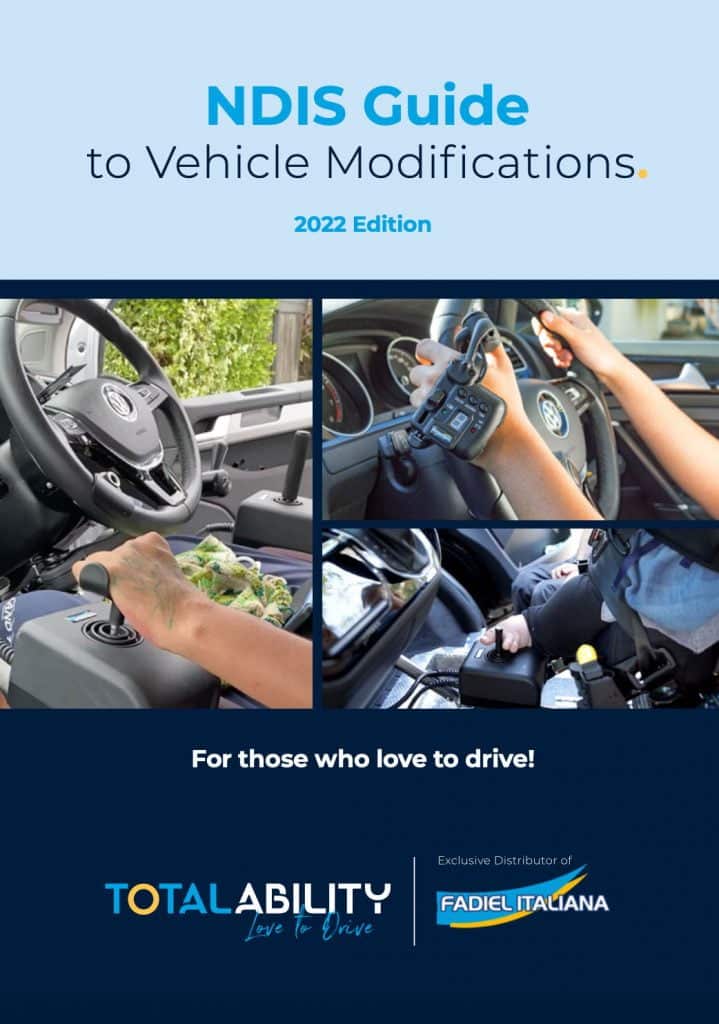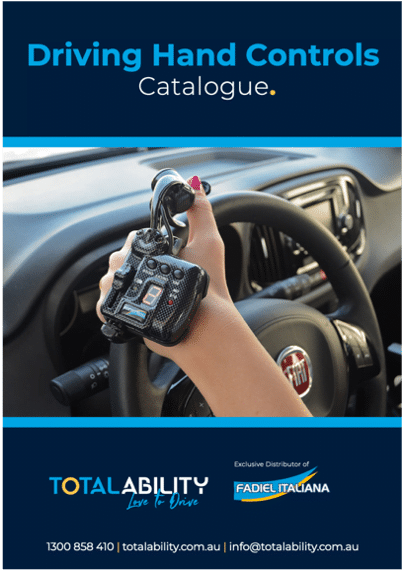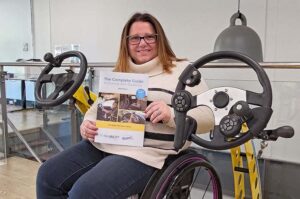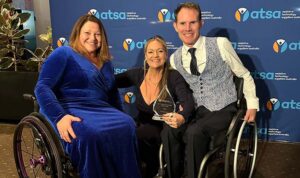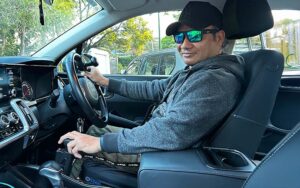
A Drifter Driven to Inspire
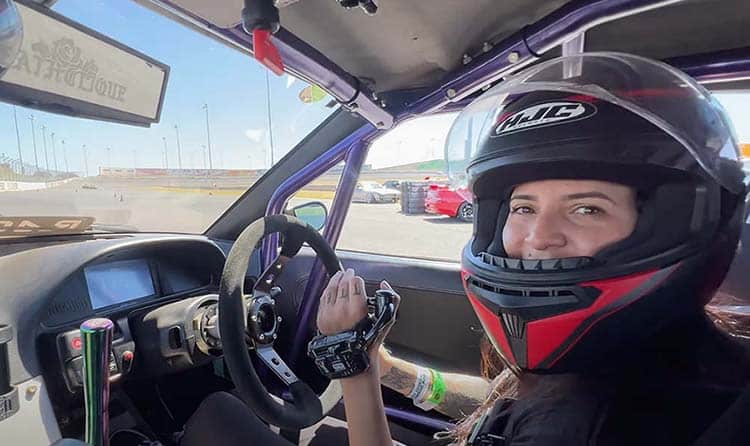
Christina Vithoulkas is a ball of contagious energy.
She is buzzing after posting a video on social media that has just clocked seven million views in only a few days, spreading around the world from her home an hour outside Melbourne.
The focus of the video is not the typical fare of Tik Tok or Instagram: it’s about a unique hand control and how Christina, a person with disability, is using it to drive a drift car.
Why so important? Christina can’t use foot pedals to control her car. Like many people with disability who can’t use their legs, she accelerates and brakes with her hands.
For some viewers, the video is a revelation, as the comments reflect. They haven’t seen someone drive with such a device, let alone one that uses bluetooth to control a car’s accelerator, integrating with the electronics.
One comment on YouTube sums it up: “Hi Christina, I recently found a reel of yours and since then I can’t stop watching your videos, you have become a role model. I am from Guatemala and I also use a wheelchair by [because of] Guillain Barre and hidden spina bifida. Now I can’t get it out of my head to have an accelerator like the one in your car.”
Christina understands: “so many people with disability just don’t know about it. The freedom the best hand control gives you. It’s just amazing compared to every other option. I really wanted to get that message out there.”
Influencing With Purpose
Christina is far from your typical ‘influencer’ seeking fame and fortune.
Her excitement about this video’s success reflects her passion for reaching not only people with disability, but the wider public.
Whilst Christina’s main mission is to be someone other people with disability can see and be inspired by – to try things they might not have thought possible – she also hopes to educate others about all aspects of living with disability.
Her videos are candid, answering any question with refreshing honesty. No topic is off limits.
“The transparency in my social media and openness is mainly for able-bodied people. There’s nothing I want to hide,” Christina explains. “People forget we are all human. Just because you’ve had an accident, you don’t need to be embarrassed about something your body just does.”
“If I share my stories and what happens to me, someone listening can feel more comfortable within themselves,” she adds. “And I think it’s contagious: by me being open, I feel other people will be more open and able to talk about their stuff.”
The Importance of Persistence
A critical part of Christina’s message is her philosophy that you need to keep going with anything you try before you can succeed at it.
“No matter what you do, if you do it 500 times or 1,000 times you’re definitely going to be better at it than the person that gave up after 10 goes even if they started out better than you.”
Christina is happy to put on record how the reality of that plays out in her life. She is sharing her ‘warts and all’ journey of beginner to better, letting all of us see how repeated attempts eventually pay dividends.
“Like a lot of people, when I was younger, I just posted the good stuff, when I did something well,” Christina recalls. “Now I want people to see the progress: you have to keep trying before it comes good.”
As someone who is trying to master a relatively difficult type of driving, that means opening herself up for plenty of ‘feedback’, some of it not very constructive!
“For some people my lack of knowledge about cars is a bit triggering, but it doesn’t bother me. I don’t have any shame in not being an expert in my area. Most people see that I share their passion, I’m having the same fun as them, I’m having a go, and they relate to that.”
Love of Extremes
Drifting cars isn’t the first form of ‘extreme’ driving that Christina has tried.
Before her accident, her first love was motorbikes. At just 19, she tried motocross and was immediately hooked.
“Growing up, I wasn’t really interested in team sports. I did play soccer in year 11 and 12, but only because the girls needed numbers. I was best and fairest in my first year, but it didn’t spark anything in me,” Christina remembers. “And then I found dirt bikes and I was like: this is something that actually makes me excited and happy. I just got straight into it – 110%!”
Four years in, and Christina had progressed to the point that she was taking on some big challenges, one of which went wrong in the worst possible way.
Attempting a 55 foot jump on her bike, she realised as soon as she took off that she wasn’t going to make it. The damage to her spine caused by the crash impact left her paralysed from her T5 vertebrae down.
New Challenges
As with many people who’ve had an accident that leaves them with a disability, the first challenge is to come to terms with the reality of a new life.
“As much as I was a goal setter, I knew when my body was saying ‘you can’t handle this’. Otherwise, you’re going to suffer, stuck in bed for a week, too tired and sore” Christina notes. “So, I learned patience at the same time as still pushing myself.”
Setting the ambitious goal of being the quickest through rehab, she left just shy of two months in.
Next was learning to adjust to life at home and show her friends and family – and herself – that she could be independent and live a normal life whilst doing the things she needed to do differently.
Getting Back to Driving
Driving wasn’t, initially, high on the list, but about ten months after her accident, Christina found a specialist driving instructor and started trialling equipment.
“I remember trying an Over Ring Accelerator and I didn’t like it. Someone suggested trying the Fadiel Satellite Accelerator and I liked the sound of it. So I spoke to my OT about it and they were hesitant to allow me to drive without testing it.”
She stuck to her guns, and began the process of modifying her car, getting approval to use the Satellite Accelerator. Around Christmas, Christina passed her test and immediately felt she had her independence back.
“First thing, I went to Maccas on my own, it was just like the best feeling.”
... Then Drifting
Not long after, Christina was invited to try drifting.
“I had no idea what it was, other than like Tokyo Drift, that movie. I thought it sounds fun, it’s going fast, I’ll do a little cheeky skid here and there!” she recalls.
“I remember going into the dressing room, then getting around the car, but I wasn’t thinking this is what I’m going to be doing,” Christina continues. “It was just me going out and having fun.”
“The moment we took the first corner, that’s when it all clicked for me. It made me feel like how a bike made me feel: the adrenaline, the rush, the speed, just everything about it.”
Before long, Christina had a plan. She began building her own drift car from a shell!
Track Debut
Zoom forward to November 2023, three and a half years of hard work later, and Christina is lining up on a track to take on level 1 of drifting, sitting behind the wheel of that car.
It’s been the work of a team of people with the final piece of the puzzle being the acquisition of another Fadiel Satellite Accelerator.
“As a person with disability, you want to be at the same level as everyone else as much as possible,” Christina maintains, “and the Satellite Accelerator gives you more ability than any other hand control. I don’t feel like I’m at a disadvantage. Every other option out there is limited.”
“Whether that’s a roundabout or a track corner, being able to have two hands on the wheel while accelerating, or one hand steering the other changing gears or doing something else, it’s the most normal feeling possible.”
Emphasising the point even further Christina notes “if Drifting ever was an Olympic Sport, I wouldn’t need to enter into the Paralympics to take part, I feel I could enter the Olympics at the same level as everyone else.”
Christina is still learning the ropes of Drifting. By documenting her journey through video, she is inspiring and educating others about the sport and her life with disability in the most entertaining way possible, amassing a legion of fans across the world.
You can follow Christina’s progress on your favourite social channel: YouTube, Instagram, Facebook and Tik Tok.
You can also find out more about the Fadiel Satellite Accelerator here.
This Guide covers:
- Initial Assessment
- Understanding the Plan
- Assistive Technology and the NDIS
- State Motoring Authorities
- Assessment Considerations
- Quotes and Evidence
- High-cost Vehicle Modifications
- Complete the NDIS Application
- After Lodgement
- Checklists
Driving Hand Controls Catalogue includes:
- Our complete range of driving hand controls
- For each control, the disabilities and conditions they are suitable for
- A comparison chart outlining the benefits and features of the various types of hand controls
- The history of Fadiel Italiana high level modification driving systems


